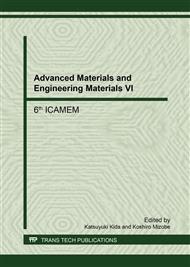[1]
T.H. Huang, Y. Pei, D. Zhang, Y. Li, K.A. Kilian, Patterned porous silicon photonic crystals with modular surface chemistry for spatial control of neural stem cell differentiation, Nanoscale. 8 (2016) 10891-10895.
DOI: 10.1039/c5nr08327c
Google Scholar
[2]
A. Lukianov, K. Murakami, C. Takazawa, M. Ihara, Formation of the seed layers for layer-transfer process silicon solar cells by zone-heating recrystallization of porous silicon structures, Appl. Phys. Lett. 108 (2016) 213904.
DOI: 10.1063/1.4951671
Google Scholar
[3]
Y. Zhao, G. Gaur, S.T. Retterer, P.E. Laibinis, S.M. Weiss, Flow-through porous silicon membranes for real-time label-free biosensing, Anal. Chem. 88 (2016) 10940-10948.
DOI: 10.1021/acs.analchem.6b02521
Google Scholar
[4]
W.Y. Tong, M.J. Sweetman, E.R. Marzouk, C. Fraser, T. Kuchel, N.H. Voelcker, Towards a subcutaneous optical biosensor based on thermally hydrocarbonised porous silicon, Biomaterials, 74 (2016) 217-230.
DOI: 10.1016/j.biomaterials.2015.09.045
Google Scholar
[5]
V. Lehmann, H. Föll, Formation mechanism and properties of electrochemically etched trenches in n-type Silicon, J. Electrochem. Soc. 137 (1990) 653-659.
DOI: 10.1149/1.2086525
Google Scholar
[6]
M. Christophersen, J. Carstensen, S. Rönnebeck, C. Jäger, W. Jäger, H. Föll, Crystal orientation dependence and anisotropic properties of macropore formation of p-and n-type silicon, J. Electrochem. Soc. 148 (2001) E267-E275.
DOI: 10.1149/1.1369378
Google Scholar
[7]
V. Depauw, H.J. Kim, G. Beaucarne, J. Poortmans, J. -P. Celis, R. Mertens, Anodisation of branched and columnar macropores in n-type silicon under front-side illumination, Phys Status Solidi C. 4 (2007) 1928-(1932).
DOI: 10.1002/pssc.200674330
Google Scholar
[8]
R. Outemzabet, N. Gabouze, N. Kesri, H. Cheraga, Random macropore formation in n-type silicon under front side illumination: correlation with anisotropic etching, Phys Status Solidi C. 2 (2005) 3394-3398.
DOI: 10.1002/pssc.200461185
Google Scholar
[9]
T. Wang, X.M. Li, W.L. Feng, W.L. Li, C. Tao, J. Wen, Structure and photoluminescence properties of the quasi-regular arrangements of porous silicon, optoelectron. adv. mat. 5 (2011) 495-498.
Google Scholar
[10]
M. Christophersen, J. Carstensen, K. Voigt, H. Föll, Organic and aqueous electrolytes used for etching macro- and mesoporous silicon, Phys Status Solidi A. 197 (2003) 34-38.
DOI: 10.1002/pssa.200306464
Google Scholar
[11]
M. Christophersen, J. Carstensen, H. Föll, Crystal orientation dependence of macropore formation in n-type silicon using organic electrolytes, Phys Status Solidi A. 182 (2000) 601-606.
DOI: 10.1002/1521-396x(200012)182:2<601::aid-pssa601>3.0.co;2-9
Google Scholar
[12]
Kurt W. Kolasinski. Etching of silicon in fluoride solutions, Surf. Sci. 603 (2009) 1904-(1911).
Google Scholar
[13]
H. Föll, M. Christophersen, J. Carstensen, G. Hasse, Formation and application of porous silicon, Mater. Sci. Eng. R. 39 (2002) 93-141.
DOI: 10.1016/s0927-796x(02)00090-6
Google Scholar
[14]
A.G. Cullis, L.T. Canham, P.D.J. Calcott, The structural and luminescence properties of porous silicon, J. Appl. Phys. 82 (1997) 909-965.
DOI: 10.1063/1.366536
Google Scholar
[15]
G.G. Qin. Extended quantum confinement/luminescence center model for photoluminescence from oxidized porous silicon and nanometer-Si-particle-or nanometer-Ge-particle-embedded silicon oxide films, Mater. Res. Bull. 33 (1998) 1857-1866.
DOI: 10.1016/s0025-5408(98)00182-2
Google Scholar


